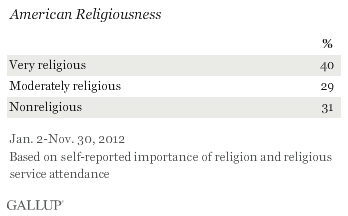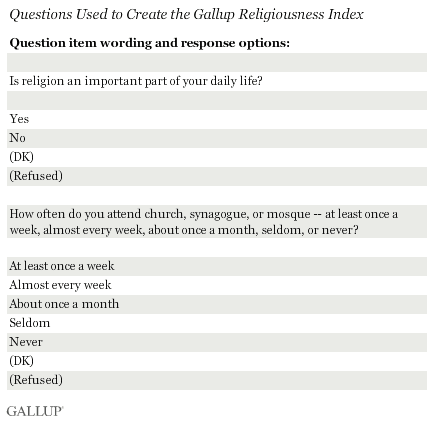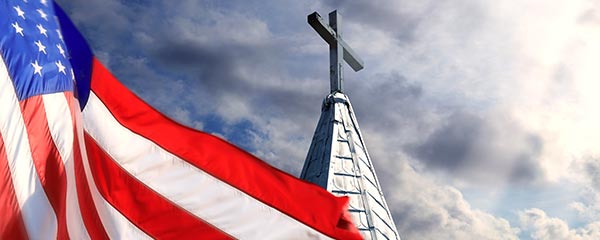PRINCETON, NJ -- Sixty-nine percent of American adults are very or moderately religious, based on self-reports of the importance of religion in their daily lives and attendance at religious services. Within that group, 40% are very religious, meaning that they attend religious services regularly and they say religion is important in their daily lives.

These data are based on more than 320,000 interviews conducted by Gallup between Jan. 2 and Nov. 30 of this year. Similar data going back to 2008 form the basis of the new book God Is Alive and Well: The Future of Religion in America.
(The wording of the two questions used to compile the measure of religiousness are available on page 2.)
Religiousness is distributed quite unequally across various subgroups and segments of the U.S. population. Key findings further discussed in the book include:
-
Religiousness increases with age, albeit not in a smooth path but rather in stages. Americans are least religious at age 23 and most religious at age 80.
-
Women are significantly more religious than men, at all ages and within all race and ethnic groups. This is not an American anomaly; women are more religious than men in all but a small number of the more than 100 countries around the world in which Gallup has measured religion.
-
Blacks are more religious than any other race or ethnic group in America.
-
Mormons are the most religious of any specific religious group in America; Jews are the least.
-
Religiousness is highest in Southern states, including Mississippi, Alabama, and Louisiana.
-
Religiousness is lowest in states located in the two northern corners of the country, including Vermont, New Hampshire, Maine, Oregon, Washington, and Alaska.
-
Upscale Americans are less religious than those with lower levels of education and income, but better-off Americans attend religious services just as often.
-
There are substantial political differences in religiousness. Republicans are significantly more likely to say that religion is important in their daily lives and more likely to attend religious services regularly than either independents or Democrats.
-
Blacks are a major exception to the significant correlation between religiousness and Republicanism. They are at the same time the most religious and the most Democratic race and ethnic group in America.
The U.S. Remains a Largely Christian Nation
Broadly speaking, the United States remains a largely Christian nation, although one in which an increasing percentage of adults say that they don't have a formal religious identity. More than three-fourths (77%) of American adults in 2012 identify with a Christian religion, including Protestantism, Catholicism, other Christian religions, and Mormonism. Among only those Americans who have a religious identity, 94% are Christians, with the rest spread across several other religious categories.
Gallup's traditional religious identity question asks respondents about their religious preference, providing these response categories: Protestant, Roman Catholic, Mormon, Jewish, Muslim, another religion, or no religion. Those who say "another religion" are then asked: "Would that be a Christian religion, or is it not a Christian religion?" Most say their "other" religion is a Christian religion.
Overall, about 52% of American adults are either Protestant or say that their preference is another religion that is Christian but not Catholic or Mormon. Twenty-three percent are Catholic, and 18% do not have a formal religious identity. Small percentages are Jewish, Mormon, Muslim, or of another religion identified as non-Christian.
Protestant Population Shrinking, "Unbranded" Religion Growing
There have been significant changes in the structure of religion in the U.S. over time. In particular, the percentage of Americans who do not have a specific religious identity has increased, while the percentage who identify as Protestant or some other non-Catholic Christian religion has decreased. This change has been accompanied by an increase in "unbranded" religion -- the growth in nondenominational churches and congregations that are loosely affiliated with traditional denominations. The percentage of Americans who identify as Catholic has stayed largely the same over time, owing in part to the influx of young Catholic Hispanic immigrants. There has been no major increase in the percentage of Americans who identify with non-Christian religions.
Religion May Be Set to Become Increasingly Important in America
God Is Alive and Well reviews potential changes in religion in the U.S going forward. Although it is always difficult to predict the future, certain trends in the age composition of the American public suggest that religion may become increasingly important in the years to come. This is mostly the result of the fact that the number of Americans who are 65 and older will essentially double over the next 20 years, dramatically increasing the number of older Americans. As long as these aging baby boomers become more religious as they age -- following the path of their elders -- the average religiousness in the population will go up.
This trend could be counterbalanced by a lowered fertility rate among younger Americans, which is important given the significant correlation between having children and being religious.
Religiousness is significantly related to well-being and health. This fact may become better known in the future, increasing the chance that Americans -- particularly aging baby boomers -- may look to religion as a positive component of their way of life. Business and government leaders may take these correlates of religiousness into account in their quest to increase employee well-being and lower healthcare costs.
Additionally, Americans have been migrating to more religious rather than less religious states over the past decade, something that could have its own effect on the religiousness of the nation.
There will be continuing changes to the ways in which people worship in the years ahead, most likely an extension of the current trends toward unbranded, nondenominational, more free-form religious expression. This has significant implications for the future of traditional mainline religious groups that are slower to adapt to change.
There may be changes to the ways in which religion relates to secular aspects of American society. One of these is politics; it is possible that in the years ahead Democrats may increasingly contest Republicans for a larger share of the vote of the very religious. Accompanying this is the possibility that very religious Americans may shift their focus from family- and values-oriented issues to broader social issues such as justice, equity, and discrimination.
The fact that women are more religious than men is discordant with the fact that large religious groups in the U.S. prohibit women from being clergy. These groups, including Catholics and Southern Baptists, may find themselves in a gender crisis of sorts, with the increasing chance of losing their most fervent members to religious groups more formally open to women at all levels of service to the church.
As the book God Is Alive and Well concludes, it is highly likely that religion will continue to be an important component of American life in the years ahead, even as the ways in which religiousness is expressed and the ways in which people worship may undergo significant change.
Survey Methods
Results for the 2012 findings on religion are based on telephone interviews conducted as part of Gallup Daily tracking Jan. 2-Nov. 30, 2012, with a random sample of 326,721 adults, aged 18 and older, living in all 50 U.S. states and the District of Columbia.
For results based on the total sample of national adults, one can say with 95% confidence that the maximum margin of sampling error is ±1 percentage point.
Interviews are conducted with respondents on landline telephones and cellular phones, with interviews conducted in Spanish for respondents who are primarily Spanish-speaking. Each sample includes a minimum quota of 400 cellphone respondents and 600 landline respondents per 1,000 national adults, with additional minimum quotas among landline respondents by region. Landline telephone numbers are chosen at random among listed telephone numbers. Cellphone numbers are selected using random-digit-dial methods. Landline respondents are chosen at random within each household on the basis of which member had the most recent birthday.
Samples are weighted by gender, age, race, Hispanic ethnicity, education, region, adults in the household, and phone status (cellphone only/landline only/both, cellphone mostly, and having an unlisted landline number). Demographic weighting targets are based on the March 2011 Current Population Survey figures for the aged 18 and older non-institutionalized population living in U.S. telephone households. All reported margins of sampling error include the computed design effects for weighting and sample design.
In addition to sampling error, question wording and practical difficulties in conducting surveys can introduce error or bias into the findings of public opinion polls.
For more details on Gallup's polling methodology, visit www.gallup.com.

